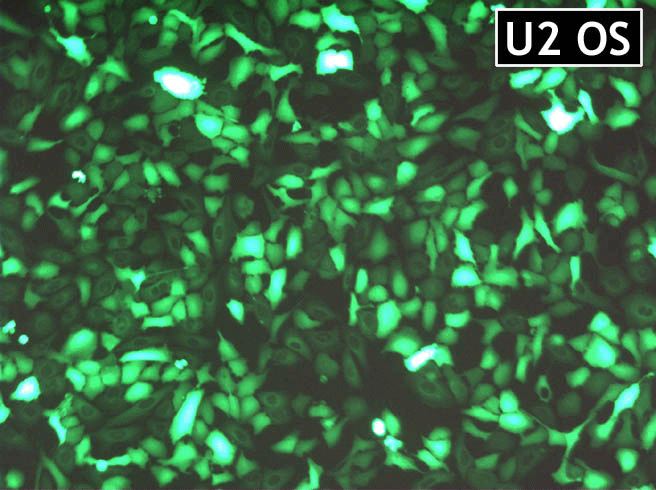EGFIE LLC
We always add value to our customers
Search by Keyword
Product Categories
GenJet™ DNA In Vitro Tranfection Reagent for U2OS cells is pre-optimized for transfecting U2OS cells. The U2OS cell line, originally known as the 2T line, was cultivated from the bone tissue of a fifteen-year-old human female suffering from osteosarcoma. Established in 1964, the original cells were taken from a moderately differentiated sarcoma of the tibia. U2 OS cells exhibit epithelial adherent morphology and viruses were not detected in the line during co-cultivation with WI-38 cells or in CF tests against SV40, RSV, or adenoviruses. Cells are positive for insulin-like growth factor I (IGF-I) and insulin-like growth factor II (IGF II) receptors and express a number of antigens, including blood type A, Rh+, HLA A2, Aw30, B12, Bw35, and B40(+/-).
Refer to the following optimal transfection conditions for maximal transfection efficiency on U2 OS cells. GenJet™ reagent, 1.0 ml, is sufficient for 300 to 600 transfections in 24 well plates or 150 to 300 transfections in 6 well plates.
| Summary of Optimal Transfection Conditions: Confluence on the day of transfection Cell culture conditions GenJet™ (µl) : DNA (µg) Ratio Diluent for DNA and Transfection Reagent Incubation Time to Form GenJet™/DNA Complex Presence of Serum/Antibiotics during Transfection Change Medium 5 Hours After Transfection Maximal Efficiency Transfection Results: Reporter Gene Plasmid Efficiency (GFP %) |
60~70% DMEM with 4.5 g/L glucose, 10% FBS 3:1 Serum-free DMEM with 4.5 g/L glucose 15 minutes at RT Yes No 48 hours EGFP pEGFP-N3 (CMV promoter) 95% |
Store at 4 °C. If stored properly, the product is stable for 12 months or longer
A Picture Showing Transfection Efficiency of GenJet™ Reagent on U2 OS Cells

GenJet™ reagent is optimized for U2OS. U2OS cells were grown per ATCC recommended culture medium and transfected with pEGFP-N3 by GenJet™. The efficiency was checked 48 hours post transfection
Data Sheet
Shopping Basket
| Items: | 0 |
| Subtotal: | $0.00 |
Note: All prices in US Dollars
customer@egfie.com